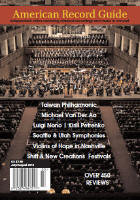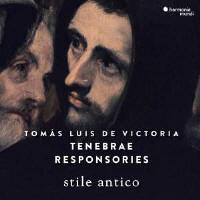Texte paru dans: / Appeared in: |
|
|
Outil de traduction ~ (Très approximatif) |
|
|
Reviewer: William
J. Gatens (Abbreviated) (This ... recording) contains masterpieces by Victoria that are among the most somber and austere of the composer’s output. The Tenebrae responsories recorded by the English vocal ensemble Stile Antico come from the composer’s Office for Holy Week (Officium Hebdomadae Sanctae) published in 1585.
Tenebrae is a special form of the office of Matins observed in the last three days of Holy Week: Maundy Thursday, Good Friday, and Holy Saturday. In monastic settings, the office would be sung at night in three nocturns for each day. As public liturgies, they are most often moved forward to the late afternoon and early evening of the preceding day so that, for example, Tenebrae for Maundy Thursday would be sung on Wednesday. Each nocturn includes three lessons, and each lesson is followed by a responsory, for a total of 27 responsories. Victoria wrote polyphonic settings of the 18 responsories for the second and third nocturns of each day. The lessons for the first nocturns come from the Lamentations of Jeremiah, and Victoria wrote polyphonic settings of the lessons (not on this recording), leaving the responsories to be sung in plainsong. The textual and musical format is the same for all of the responsories: antiphon, respond, verse, repeat of the respond. The antiphons and responds are in four parts, but the verses are in three parts. The verse of the first responsory for Maundy Thursday is in two parts. The outer responsories are SATB, but the second responsory of each nocturn is SSAT. By longstanding custom, these can be transposed down an octave and sung by tenors and basses. That option is taken in two of the responsories here. These responsories were never intended to be sung in succession. In their liturgical setting, they would be polyphonic blooms in an office sung mostly in plainchant. It is for individual listeners to decide whether a succession of pieces so similar in tempo, style, and subject make a satisfying program. In this recording, the responsories for each day are followed by a chanted lesson from Lamentations.
Stile Antico is 12 mixed voices. An additional tenor and bass sing in some of the tracks. In the ideal of vocal chamber music, they sing without a conductor. In technical polish, they leave nothing to be desired. Their performances are understated but deeply expressive. They conclude their program with the six-part Holy Week motet ‘O Domine Jesu Christe’, published by the composer in a collection of 1576. The texture is more sumptuous than the four parts of the responsories, yet has the somber austerity appropriate to the time. | |
|
|
|
|
Cliquez l'un ou l'autre
bouton pour découvrir bien d'autres critiques de CD |
|




